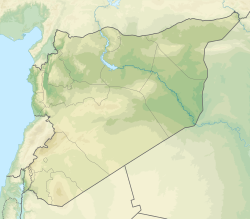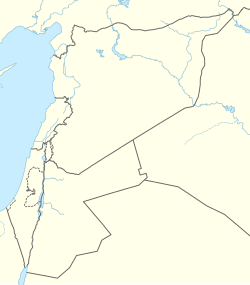
Back Schlacht am Jarmuk GSW معركة اليرموك Arabic Yərmuq döyüşü Azerbaijani یرموق دؤیوشو AZB Йәрмүк һуғышы Bashkir Битка при Ярмук Bulgarian ইয়ারমুকের যুদ্ধ Bengali/Bangla Bitka na Jermuku BS Batalla del Yarmuk Catalan شەڕی یەرمووک CKB
The Battle of the Yarmuk (also spelled Yarmouk; Arabic: معركة اليرموك) was a major battle between the army of the Byzantine Empire and the Arab Muslim forces of the Rashidun Caliphate, and a crucial point in the Muslim conquest of the Levant. The battle consisted of a series of engagements that lasted for six days in August 636, near the Yarmouk River (called the Hieromykes River by the Greeks), along what are now the borders between Syria and Jordan and Syria and Israel, southeast of the Sea of Galilee. The result of the battle was a decisive Muslim victory that ended Roman rule in Syria after about seven centuries. The Battle of the Yarmuk is regarded as one of the most decisive battles in military history,[6][7] and it marked the first great wave of early Muslim conquests after the death of the Islamic prophet Muhammad, heralding the rapid advance of Islam into the then-Christian/Roman Levant.
To check the Arab advance and to recover lost territory, Emperor Heraclius had sent a massive expedition to the Levant in May 636. As the Byzantine army approached, the Arabs tactically withdrew from Syria and regrouped all their forces at the Yarmuk plains close to the Arabian Peninsula, where they were reinforced, and defeated the numerically superior Byzantine army. The battle is widely regarded to be Khalid ibn al-Walid's greatest military victory and to have cemented his reputation as one of the greatest tacticians and cavalry commanders in history.[8]
- ^ Nicolle 1994, pp. 64–65.
- ^ Akram 2004, p. 425.
- ^ "Battle of Yarmouk". Encyclopædia Britannica. Encyclopædia Britannica, Inc. Retrieved 5 June 2025.
Losses: Byzantine allied, 40,000; Arab, 5,000.
- ^ a b Bolshakov (2002), p. 67.
- ^ "Khālid ibn al-Walīd". Encyclopædia Britannica. Encyclopædia Britannica, Inc. Retrieved 17 June 2025.
Early in 636 he withdrew south of the Yarmūk River before a powerful Byzantine force that advanced from the north and from the coast of Palestine. The Byzantine armies were composed mainly of Christian Arab, Armenian, and other auxiliaries, however; and when many of these deserted the Byzantines, Khālid, reinforced from Medina and possibly from the Syrian Arab tribes, attacked and destroyed the remaining Byzantine forces along the ravines of the Yarmūk valley (Aug. 20, 636).Almost 50,000 Byzantine troops were slaughtered, which opened the way for many other Islamic conquests.
- ^ Nafziger & Walton 2003, p. 30.
- ^ Nicolle 1994, p. 6.
- ^ Nicolle 1994, p. 19.



